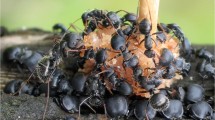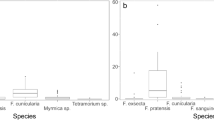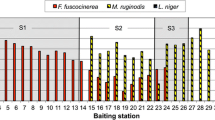Abstract
Mosaics of exclusive foraging territories, produced by intra-and interspecific competition, are commonly reported from arboreal ant communities throughout the tropics and appear to represent a recurring feature of community organization. This paper documents an ant mosaic within mangrove forests of Panama and examines the behavioral mechanisms by which one of the common species, Azteca trigona, maintains its territories. Most of the mangrove canopy is occupied by mutually exclusive territories of the ants A. trigona, A. velox, A. instabilis, and Crematogaster brevispinosa. When foraging workers of A. trigona detect workers of these territorial species, they organize an alarm recruitment response using pheromonal and tactile displays. Nestmates are attracted over short distances by an alarm pheromone originating in the pygidial gland and over longer distances by a trail pheromone produced by the Pavan's gland. Recruits are simultaneously alerted by a tactile display. No evidence was found for chemical marking of the territory. Major workers are proportionally more abundant at territory borders than on foraging trails in the interior of the colony. The mechanisms of territory defense in A. trigona are remarkably similar to those of ecologically analogous ants in the Old World tropics.
Similar content being viewed by others
References
Adams ES (1990) Boundary disputes in the territorial ant Azteca trigona: effects of asymmetries in colony size. Anim Behav 39:321–328
Adams ES, Levings SC (1987) Territory size and population limits in mangrove termites. Anim Ecol 56:1069–1081
Brown ES (1959) Immature nutfall of coconuts in the Solomon Islands. I. Distribution of nutfall in relation to that of Amblypelta and of certain species of ants. Bull Ent Res 50:97–133
Brown ES (1960) Immature nutfall of coconuts in the Solomon Islands. II. Changes in ant populations, and their relation to vegetation. Bull Ent Res 50:523–558
Cammaerts MC, Morgan ED, Tyler R (1977) Territorial marking in the ant Myrmica rubra. Biol Behav 2:263–272
Carroll CR (1979) A comparative study of two ant faunas: The stem-nesting ant communities of Liberia, West Africa, and Costa Rica, Central America. Am Nat 113:551–561
Cole AC Jr, Jones JW Jr (1948) A study of the weaver ant, Oecophylla smaragdina (Fab.). Am Midl Nat 39:641–651
Detrain C, Pasteels JM (1992) Caste polyethism and collective defense in the ant, Pheidole pallidula: the outcome of quantitative differences in recruitment. Behav Ecol Sociobiol 29:405–412
Feener DH Jr (1988) Effects of parasites on foraging and defense behavior of a termitophagous ant, Pheidole titanis Wheeler (Hymenoptera: Formicidae). Behav Ecol Sociobiol 22:421–427
Hölldobler B (1979) Territories of the African weaver ant (Oecophylla longinoda (Latreille)): A field study. Z Tierpsychol 51:201–213
Hölldobler B (1981) Foraging and spatiotemporal territories in the honey ant Myrmecocystus mimicus Wheeler (Hymenoptera: Formicidae). Behav Ecol Sociobiol 9:301–314
Hölldobler B (1983) Territorial behavior in the green tree ant (Oecophylla smaragdina) Biotropica 15:241–250
Hölldobler B, Lumsden CJ (1980) Territorial strategies in ants. Science 210:732–739
Hölldobler B, Wilson EO (1978) The multiple recruitment systems of the African weaver ant Oecophylla longinoda (Latreille) (Hymenoptera: Formicidae). Behav Ecol Sociobiol 3:19–60
Hölldobler B, Wilson EO (1990) The ants. Belknap Press of Harvard University Press, Cambridge, Massachusetts
Jackson DA (1984) Ant distribution patterns in a Cameroonian cocoa plantation: investigation of the ant mosaic hypothesis. Oecologia 62:318–324
Jaffe K (1986) Nestmate recognition and territorial marking in Solenopsis geminata and in some Attini. In: Lofgren CS, Van der Meer, RK (eds) Fire Ants and leaf-cutter ants: Biology and management. Westview Press, Boulder, Colorado, pp 211–222
Jutsum AR, Cherrett JM, Fisher M (1981) Interactions between the fauna of citrus trees in Trinidad and the ants Atta cephalotes and Azteca sp. J Appl Ecol 18:187–195
Leston D (1973a) Ecological consequences of the tropical ant mosaic. Proc 7th Internat Congress of the IUSSI, London: 235–242
Leston D (1973b) The ant mosaic-tropical tree crops and the limiting of pests and diseases. PANS 19:311–341
Leston D (1978) A neotropical ant mosaic. Ann Entomol Soc Am 71:649–653
MacKay WP, Vinson SB (1989) A guide to species identification of New World ants. Sociobiology 16:3–47
Majer JD (1972) The ant mosaic in Ghana cocoa farms. Bull Ent Res 62:151–160
Majer JD (1976a) The ant mosaic in Ghana cocoa farms: Further structural considerations. J Appl Ecol 13:145–155
Majer JD (1976b) The maintenance of the ant mosaic in Ghana cocoa farms. J Appl Ecol 13:123–144
Rai BK (1977) Damage to coconut palms by Azteca sp. (Hymenoptera: Formicidae) and insecticidal control with bait, in Guyana. Bull Ent Res 67:175–183
Room PM (1971) The relative distribution of ant species in Ghana's cocoa farms. J Anim Eco 140:735–751
Room PM (1975a) Diversity and organization of the ground foraging ant faunas of forest, grassland and tree crops in Papua New Guinea. Aust J Zool 23:71–89
Room PM (1975b) Relative distribution of ant species in cocoa plantations in Papua New Guinea. J Appl Ecol 12:47–61
Salzemann A, Jaffe K (1990) On the territorial behaviour of field colonies of the leaf-cutting ant Atta laevigata (Hymenoptera: Myrmicinae). J Insect Physiol 36:133–138
Seeley TD (1985) Honeybee ecology. Princeton University Press, Princeton
Strickland AH (1951) The entomology of swollen shoot of cacao. II. The bionomics and ecology of the species involved. Bull Ent Res 42:65–103
Sokal RR, Rohlf FJ (1981) Biometry, 2nd Ed. W.H. Freeman and Co. San Francisco
Traniello JFA (1980) Colony specificity in the trail pheromone of an ant. Naturwissenschaften 67:361
Traniello JFA (1981) Enemy deterrence in the recruitment strategy of a termite: soldier-organized foraging in Nasutitermes costalis. Proc Natl Acad Sci USA 78:1976–1979
Traniello JFA (1983) Social organization and foraging success in Lasius neoniger (Hymenoptera: Formicidae): behavioral and ecological aspects of recruitment communication. Oecologia 59:94–100
Vanderplank FL (1960) The bionomics and ecology of the red tree ant, Oecophylla sp. and its relationship to the coconut bug Pseudotheraptus wayi Brown (Coreidae). J Anim Ecol 29:15–33
Way MJ (1953) The relationship between certain ant species with particular reference to biological control of the coreid, Theraptus sp. Bull Ent Res 44:669–691
Way MJ (1954) Studies on the life history and ecology of the ant Oecophylla longinoda Latreille. Bull Ent Res 45:93–112
Weber NA (1946) Dimorphism in the African Oecophylla worker and an anomaly (Hym: Formicidae). Ann Entomol Soc Am 39:7–10
Weber NA (1949) The functional significance of dimorphism in the African weaver ant, Oecophylla. Ecology 30:397–400
Wheeler JW, Evans SL, Blum MS, Torgerson RL (1975) Cyclopentyl ketones: Identification and function in Azteca ants. Science 187:254–255
Wheeler DE (1986) Polymorphism and division of labor in Azteca chartifex laticeps (Hymenoptera: Formicidae). J Kans Entomol Soc 59:542–548
Wilson EO (1976) The organization of colony defense in the ant Pheidole dentata Mayr (Hymenoptera: Formicidae). Behav Ecol Sociobiol 1:63–81
Author information
Authors and Affiliations
Rights and permissions
About this article
Cite this article
Adams, E.S. Territory defense by the ant Azteca trigona: maintenance of an arboreal ant mosaic. Oecologia 97, 202–208 (1994). https://doi.org/10.1007/BF00323150
Received:
Accepted:
Issue Date:
DOI: https://doi.org/10.1007/BF00323150




